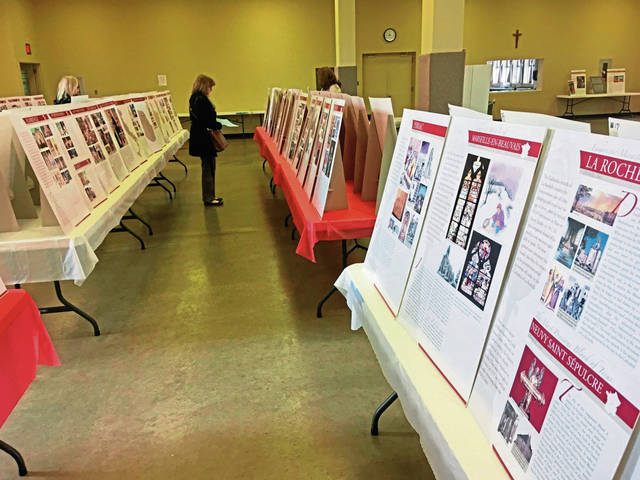'Eucharistic miracles' showcased at South Greensburg church
The age of miracles is not over — or so says an exhibit of “Eucharistic miracles” on display through Saturday at St. Bruno Parish in South Greensburg.
The exhibit comprises 140 panels that explain and illustrate the phenomenon of Eucharistic miracles in the Catholic Church through the centuries, from the 300s in Italy to the 1990s in the former Argentinian diocese of Pope Francis.
Organizers say the “Eucharistic Miracles of the World” exhibit, which is approved by the Vatican through the Pontifical Academy Cultorum Martyrum, is meant to strengthen the faith of believers and is an appropriate activity for Lent.
“Most people who come in here truly believe in the real presence of Jesus in the Eucharist. They come away with their faith being renewed,” said Patti Holtzer, a St. Paul parishioner who staffed the exhibit Wednesday.
The exhibit opened at St. Paul, St. Bruno’s partner parish, on March 9 and will close at 7 p.m. Saturday. An estimated 130 people viewed it at St. Paul, and so far, about 30 people have seen it at St. Bruno.
Donna Sunseri, member of the St. Bruno- St. Paul Perpetual Adoration Team, said local interest in Eucharistic miracles has grown since the exhibit was first shown in 2015. Since then, St. Bruno opened a Eucharistic chapel that is open daily for people to pray before the Blessed Sacrament — a consecrated host that is displayed in a special holder called a monstrance.
“We feel it’s part of our mission to spread the message of the true presence of the Lord (in the Eucharist),” Sunseri said. “It’s our hope that one day we can have 24/7 adoration.”
Catholics believe that the bread and wine that is consecrated during the Mass becomes the body and blood of Christ. Eucharistic miracles are supernatural phenomena associated with the consecrated Communion elements — everything from healings to instances when the elements change into flesh and blood, according to the exhibit.
While Catholics are not obliged to believe in Eucharistic miracles, they “must not exclude the possibility that God may intervene in an extraordinary way in any given moment, place, event or person,” according to the exhibit catalog.
Sunseri said belief in miracles and devotion to the Blessed Sacrament used to be a common feature of Catholic life.
“There’s been a falling away from a lot of church devotions since Vatican II. Adoration has fallen away. Many young people today — their parents were not raised with it,” she said.
One young person whom exhibit organizers praise is Carlo Acutis, an Italian teenager whose research into Eucharistic miracles led to the development of the exhibit on display at St. Bruno. Acutis died in 2006 at age 15 after being diagnosed with leukemia.
“All the panels (in the exhibit) were developed by Carlo. He did all that by searching the internet,” said William Ryckman, who owns the exhibit and makes it available to churches free of charge. “He took it all to the Vatican and got approval for it.”
What’s more, all of the miracles described in the exhibit have been investigated and authenticated by the Vatican, said Ryckman, a retired family physician from Sutersville. The cause for Carlo’s sainthood has already been launched by the Diocese of Milan.
Ryckman said he and his wife acquired the exhibit in 2008 from the Real Presence Eucharistic Education and Adoration Association of Lombard, Ill.
The most recent authenticated miracle happened in Tixtla, Mexico, in 2006, when a Communion host being distributed by a nun began exuding blood, Ryckman said. The blood typing later showed it to be AB.
“It’s the same blood type as all the others (found in recent decades). … You just have to believe it,” he said.
Exhibit hours are 2-8 p.m. Thursday, 8:30 a.m. to 9 p.m. Friday and 12-7 p.m. Saturday.
Remove the ads from your TribLIVE reading experience but still support the journalists who create the content with TribLIVE Ad-Free.

